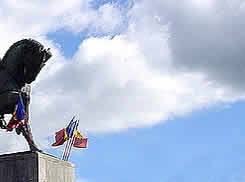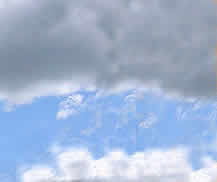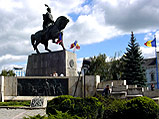
 |
 |
 |
The Mihai Viteazul Square is dominated by the equestrian
statue of Michael the Brave (Mihai Viteazul 1558-1601) and is bordered
by a few former palaces of fine architecture, but contains as well elements
of communist architecture.
Although the 1600 union of the three Romanian principalities (Moldavia, Tara Romaneasca and Transylvania), which was realized under his reign, did not take place in Cluj, the city maintained many commercial, political and economic affairs with Michael the Brave. The legends say that his son, Patrascu, studied at the Jesuite College in Cluj. Yet the citizens and the leadership of the town were never submitted to him, more, they plotted against him. Although the city was granted with many privileges, the climax of the conflict of the city with the great ruler was the burning at stakes of his beloved captain, Baba Novac, in 1601, shortly before the death of the former.
The square – until then named Szechenyi Istvan - was changed to Michael the Brave in 1919, shortly after the Great Union (1918), in the memory of the first Romanian who united all the Romanians under his rule. The square had began gaining commercial importance in the second half of the XIXth century, after a railroad was built across the square, which transported merchandise and people, bringing about the prosperity of the area. The town market was moved here from its central location. The rail line was not a success though, as a consequence of its numerous accidents, its last transportation, in 1902, being that of the pieces of the Statue of Matei Corvin.
Although the 1600 union of the three Romanian principalities (Moldavia, Tara Romaneasca and Transylvania), which was realized under his reign, did not take place in Cluj, the city maintained many commercial, political and economic affairs with Michael the Brave. The legends say that his son, Patrascu, studied at the Jesuite College in Cluj. Yet the citizens and the leadership of the town were never submitted to him, more, they plotted against him. Although the city was granted with many privileges, the climax of the conflict of the city with the great ruler was the burning at stakes of his beloved captain, Baba Novac, in 1601, shortly before the death of the former.
The square – until then named Szechenyi Istvan - was changed to Michael the Brave in 1919, shortly after the Great Union (1918), in the memory of the first Romanian who united all the Romanians under his rule. The square had began gaining commercial importance in the second half of the XIXth century, after a railroad was built across the square, which transported merchandise and people, bringing about the prosperity of the area. The town market was moved here from its central location. The rail line was not a success though, as a consequence of its numerous accidents, its last transportation, in 1902, being that of the pieces of the Statue of Matei Corvin.

 |
 |
||||||
|
|
|||||||
 |
 |
The Michael the Brave Square is linked with the railway
station by a bridge and a boulevard named Horea. On the sides of this
bridge stand the former Szekely Palace, built in new Gothic style in 1893,
and the Urania Palace, erected in Secession style in 1910.
The architecture of the square was reshaped in the ‘50s, when the houses which did not fit into the plans were demolished and replaced by blocks of flats.
The equestrian statue designed by Marius Butunoiu was placed there in 1976. The square also had a sad fame, as it was the favourite place for the political festivities in the communist years.
At present, the development plans of the area include a multi-level parking to be built behind the Hala Agroalimentara, to provide parking places for the growing number of cars of the city.
The architecture of the square was reshaped in the ‘50s, when the houses which did not fit into the plans were demolished and replaced by blocks of flats.
The equestrian statue designed by Marius Butunoiu was placed there in 1976. The square also had a sad fame, as it was the favourite place for the political festivities in the communist years.
At present, the development plans of the area include a multi-level parking to be built behind the Hala Agroalimentara, to provide parking places for the growing number of cars of the city.




|
www.CLUJonline.com © 2005-2014
All Rights Reserved
|






